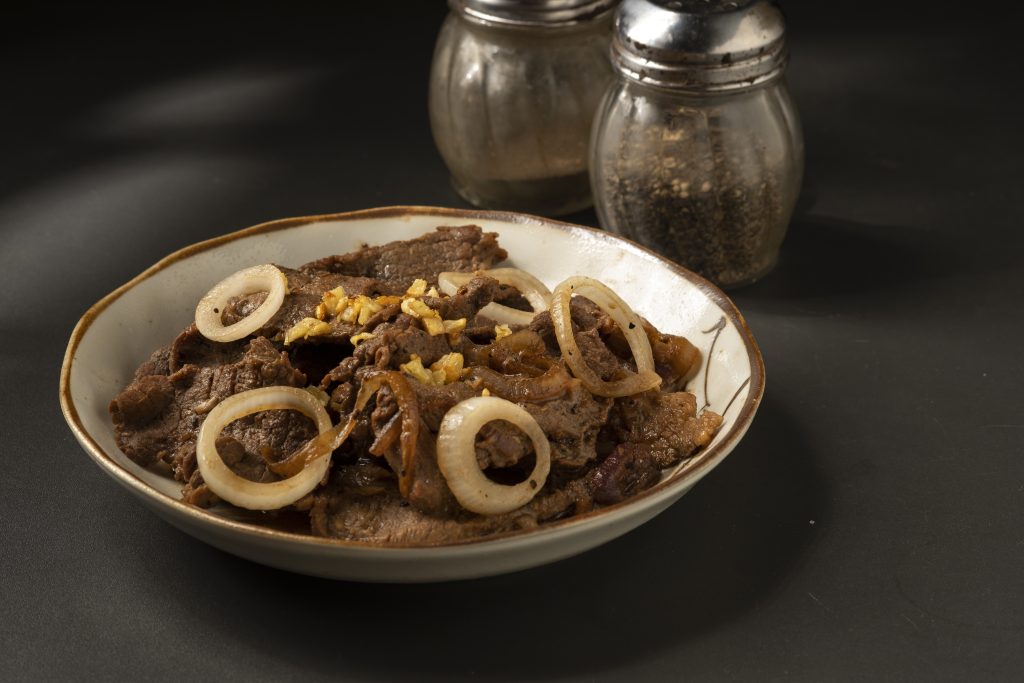
Bistek Tagalog, or Filipino beef steak, is one of the most beloved dishes in the Philippines. Its savory and tangy flavors, combined with tender beef and caramelized onions, make it a comforting meal for many Filipinos. Whether served with steaming hot rice or enjoyed as a main dish during family gatherings, Bistek Tagalog continues to be a favorite in Filipino cuisine.
In this guide, we’ll dive deep into everything you need to know about Bistek Tagalog—from its origins, the best ingredients to use, step-by-step cooking instructions, and expert tips to make the perfect bistek every time.
What is Bistek Tagalog?
Bistek Tagalog is the Filipino version of beef steak, typically made with thinly sliced beef marinated in soy sauce, calamansi juice, and garlic, then simmered until tender. The dish is topped with caramelized onions and served with a rich, flavorful sauce.
Unlike Western-style steaks that are grilled or seared, Bistek Tagalog is braised, allowing the flavors to fully infuse into the beef, creating a melt-in-your-mouth experience.
Origins of Bistek Tagalog
The name “Bistek” comes from the Spanish word bistec, meaning beef steak. The dish has strong Spanish influences, as Spain colonized the Philippines for over 300 years. However, Filipinos have given it a unique twist by using local ingredients such as calamansi instead of lemon and incorporating soy sauce for a rich umami flavor.
Over time, Bistek Tagalog has evolved into a staple dish in Filipino households, often passed down from generation to generation.
Health Benefits of Bistek Tagalog
Bistek Tagalog is not just delicious—it also has several health benefits:
- Rich in Protein: Beef provides essential amino acids for muscle growth and repair.
- Good Source of Iron: Helps prevent anemia and supports oxygen transport in the blood.
- Contains Antioxidants: Onions and calamansi juice contain antioxidants that support overall health.
- Low-Carb Option: Ideal for those following a low-carb or keto diet (just skip the rice!).
Essential Ingredients for Bistek Tagalog
To make authentic Bistek Tagalog, you’ll need the following ingredients:
Main Ingredients:
- 500g beef sirloin or top round – Thinly sliced for quick cooking.
- 4 tbsp soy sauce – Provides a deep umami flavor.
- 3 tbsp calamansi juice (or lemon juice) – Adds a tangy, slightly sweet taste.
- 1 medium onion, sliced into rings – For caramelized onion topping.
- 3 cloves garlic, minced – Enhances the overall taste.
- 1/2 cup water or beef broth – Helps tenderize the meat.
- 1/2 tsp black pepper – Adds a mild heat.
- 2 tbsp cooking oil – For sautéing.
Optional Ingredients for a Flavor Boost:
- 1 tsp sugar – To balance acidity and saltiness.
- 1 tbsp oyster sauce – For extra umami richness.
- 1 tbsp butter – To enhance the beef’s flavor.
Step-by-Step Guide to Cooking the Perfect Bistek Tagalog
Step 1: Marinate the Beef
- In a bowl, combine soy sauce, calamansi juice, black pepper, and garlic.
- Add the thinly sliced beef and marinate for at least 30 minutes to 1 hour (for best results, marinate overnight in the fridge).
Step 2: Cook the Onions
- Heat 1 tbsp cooking oil in a pan over medium heat.
- Add the sliced onions and sauté until they become soft and slightly caramelized.
- Remove from the pan and set aside.
Step 3: Sear the Beef
- In the same pan, add another 1 tbsp of oil and increase the heat to medium-high.
- Remove the beef from the marinade, shaking off excess liquid.
- Sear the beef slices for 1-2 minutes per side until browned.
- Set the beef aside.
Step 4: Simmer the Bistek
- Pour the remaining marinade and 1/2 cup water or beef broth into the pan.
- Bring to a gentle simmer, then add the beef back in.
- Cover and simmer for 15-20 minutes until the beef is tender.
Step 5: Add the Onions & Final Touches
- Add the caramelized onions on top.
- Optional: Stir in 1 tsp sugar and 1 tbsp butter for extra flavor.
- Simmer for another 2-3 minutes, then turn off the heat.
Step 6: Serve and Enjoy
- Serve the Bistek Tagalog with steamed white rice.
- Garnish with additional onion rings for extra flavor.
Expert Tips for the Best Bistek Tagalog
✅ Choose the Right Cut of Beef: Use sirloin, top round, or flank steak for the best texture. Avoid tough cuts unless slow-cooking.
✅ Marinate Longer for Maximum Flavor: Overnight marination makes the beef extra flavorful.
✅ Caramelize Onions for Depth of Flavor: Slowly cooking onions releases natural sweetness, balancing the tangy and salty taste.
✅ Use Fresh Calamansi: Fresh calamansi juice gives a more authentic taste than bottled lemon juice.
✅ Control the Sauce Consistency: If you prefer a thicker sauce, let it reduce for a few extra minutes before serving.
Frequently Asked Questions (FAQs)
1. What is the best beef cut for Bistek Tagalog?
Sirloin, top round, or flank steak work best because they are tender and absorb marinades well.
2. Can I use chicken instead of beef?
Yes! Simply substitute chicken breast or thighs and reduce cooking time to prevent overcooking.
3. Can I cook Bistek Tagalog without soy sauce?
Soy sauce is a key ingredient, but you can use coconut aminos for a soy-free version.
4. How do I store and reheat Bistek Tagalog?
Store leftovers in an airtight container in the refrigerator for up to 3 days.
To reheat, warm it in a pan over low heat or microwave for 1-2 minutes.
Why Bistek Tagalog is a Must-Try Dish
Bistek Tagalog is more than just a meal—it’s a Filipino comfort food that brings families together. With its savory, tangy, and slightly sweet flavor, it’s no wonder that this dish has remained a favorite across generations.
If you’ve never made Bistek Tagalog before, now is the perfect time to try! Follow this guide, experiment with flavors, and enjoy a delicious homemade Filipino beef steak.
Final Thoughts
Now that you know how to cook the best Bistek Tagalog, it’s time to put your skills to the test. Whether you’re cooking for yourself, your family, or a special gathering, this classic Filipino dish is sure to impress.
Have you tried making Bistek Tagalog? Share your experience in the comments below! And don’t forget to share this recipe with your friends who love Filipino food!

